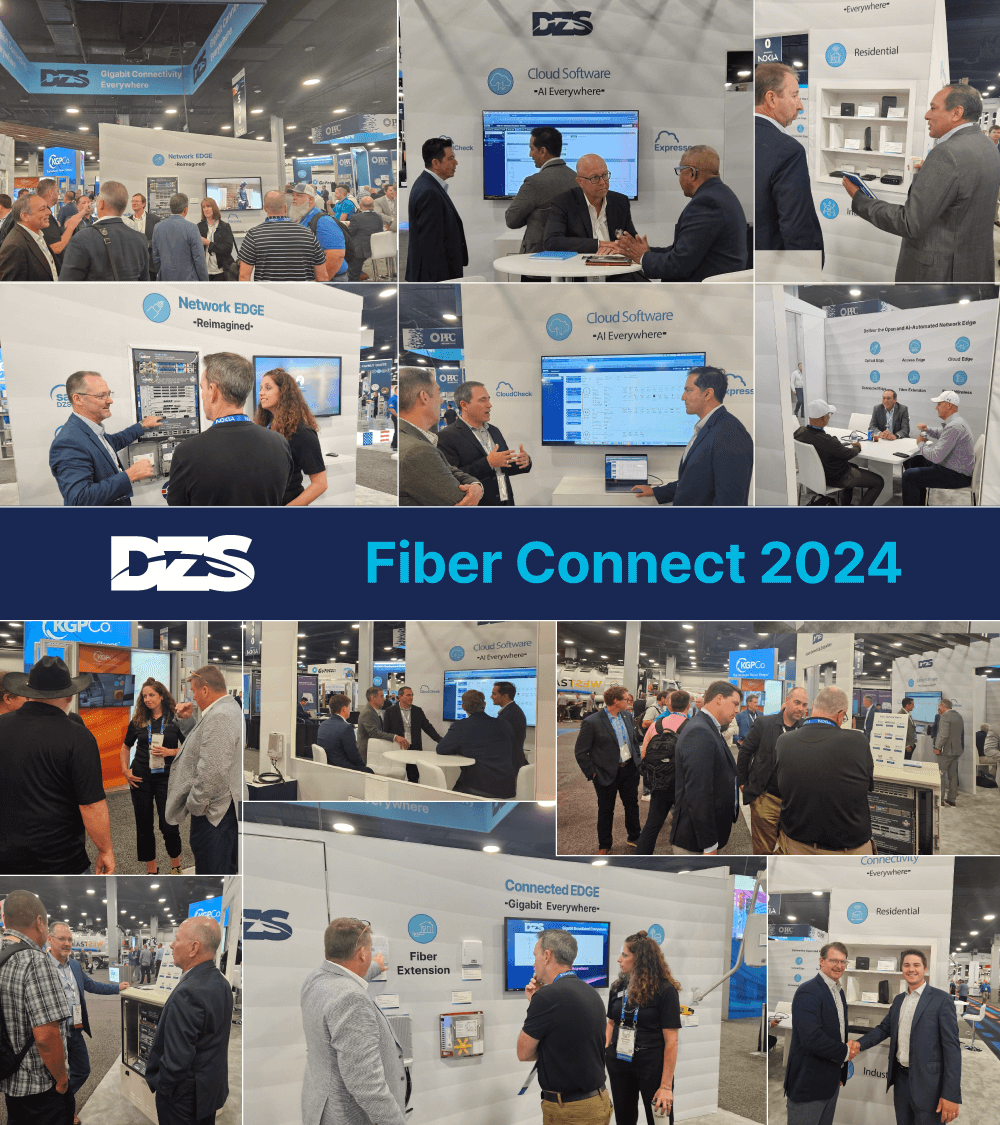Fiber is ready for its close-up…
Another Fiber Connect show is behind us, and it was gratifying to witness first-hand the amazing progress that we have made as an industry since I attended my first Fiber-to-the-Home show (Fiber Connect’s predecessor) nearly 20 years ago. Since then, fiber networks have transitioned from a yet-to-be-proven possible architecture to the de facto standard for the telecom industry. Back in 2005, the rules for U.S. government loans and support for rural broadband had virtually no mechanism for funding fiber buildouts. Now, the largest government programs like the $42.5 billion Broadband Equity, Access and Deployment (BEAD) Program in the U.S. and similar initiatives in other countries highly favor fiber. Even the number of attendees, both on the service provider and the vendor side, has grown by over an order of magnitude, with nearly 4500 attendees participating in Fiber Connect 24 (FC24).
Even with these dramatic changes over time, the rate of change in the fiber industry globally has continued to accelerate. Fiber Connect is always a great touchstone for taking stock of transformation in the communications industry and understanding its impact. Let’s look at the hottest topics of Fiber Connect 24, and what they mean for the industry going forward.
A shift from homes passed to homes connected
As I moderated one of the first panels of the FC24 pre-conference workshops on Sunday, July 28, “Post Deployment – What Comes Next? Building More than a Bigger Pipe”, it was clear the panelists were of the mindset that the industry has moved on from thinking about how to get fiber deployed in their communities to how they could make the most out of their fiber deployments. To clarify this point, panelist Michael Render, founder and president of leading fiber market analyst firm RVA, shared that his firm predicts 80% of U.S. households would be passed by fiber by 2030, and over 60% are passed today. Panelists from the Holland Board of Publics Works in Michigan and Centranet in Oklahoma shared that their communities are well covered by fiber already and their attention is now focused on ensuring that they have the highest possible take rates for the fiber service in their respective markets to help offset investment costs.
A typical challenge they saw were multiple dwelling units (MDUs) which often were passed by fiber, but difficult to deploy into due to access issues, building owner rules and existing contracts. In these cases, fiber extension solutions like Gfast were seen as essential to driving take rates and connection due to their ability to use existing copper and coaxial infrastructure in these buildings to offer symmetrical gigabit speeds identical to their fiber customers while also overcoming access issues and owner impediments. Key to this success is the ability to use remote power to facilitate turn-up and for these solutions to be managed via the same mechanism as their FTTP network. Using fiber extension solutions like Gfast, enables providers to get to market faster than would have otherwise been possible and continue to add more subscribers onto their networks. DZS offers world-leading fiber extension solutions to address their challenge head on. For more information click here.

A new focus on what technology is next after XGS-PON
With XGS-PON technology capable of delivering symmetrical 10G broadband services now the predominant technology being deployed in the industry, service providers are starting to see how multi-gigabit services are faring in their own markets. The results are rapidly causing them to think about what future technologies they are going to deploy, and their path to implementing those services. During my panel discussion, an executive from Centranet shared that over 50% of the subscribers in his network have increased their service package to a symmetrical gigabit service. He was convinced that were he to offer a multi-gigabit service at a reasonable price uplift, he would immediately see 25% of his subscriber take it immediately. This was corroborated by other service providers on the FC24 show floor, who all shared examples of very strong uptake of multi-gig services. A combination of the growth of work-from-home, gaming, streaming proliferation, and concurrent use within the home seem to be making consumers less price sensitive as well as thirsty for high-end performance. This raised a number of questions for both my panelists and my audience as they thought about their own markets:
- Should they be putting more energy into multi-gig service offerings?
- If so, how long would it be before they needed to upgrade to the next technology?
- How would they manage these upgrades?
- Will 50G PON be the right choice?
With regard to the first question, the answer was a pretty clear “Yes!” There were many datapoints shared during FC24 suggesting that service providers who were not offering multi-gig service were at the least leaving money on the table, and at worst were inviting competitive churn. Data and trends gleaned from DZS AI-driven software products like CloudCheck and Expresse can aid in identifying subscribers who are ready to upgrade. With regard to how long should it be before they consider a technology upgrade, the answer it also very straightforward – given bandwidth consumption trends and the demand for multi-gig services, service providers should be thinking about the future now. Although some vendors are suggesting 25G PON as the next step, most vendors and carriers alike at the show saw symmetrical 50G PON as the next logical step to plan for, and see it coming to market in 2025. At FC24, DZS demonstrated how its Velocity platforms can handle 5x capacity leap that 50G PON will require with a non-blocking architecture, and do so cost effectively with an in-place card upgrade.
A realization that middle mile (edge transport) capacity is an under-appreciated variable in broadband services success
One of the main keynote panels on day 1 of FC24 was “Middle Mile Networks: Defining the Road Ahead”. It was coincidentally moderated by Centranet, who was also on my pre-conference panel, and featured DZS CEO Charlie Vogt. One of the main points made by Centranet was a phenomenon described as “Beautiful Roads, Crappy Highways” meant to convey that it makes little sense for service providers to build next generation fiber access networks in the communities they serve only to be service constrained by a low-bandwidth transport network feeding it. The other panelists from Mid-Atlantics Broadband, Diamond State Networks, AFL and DZS all strongly agreed. They all shared that in the U.S., a government program was created to help service providers address this challenge head-on, only to find out that request for funds for this program was over five times high than the funds made available. Clearly this is a major area of concern, and the challenge is just beginning as it was rumored that the Google AI-driven operations center in Memphis, Tennessee was going to require 80 Tbps of transport connectivity just to communicate with Google operations in Texas. As DZS CEO Vogt pointed out, this is in contrast with the 1 to 10 Gbps transport networks that currently connect most of rural America. He explained that AI and other applications like AR/VR/XR and telehealth will require at a minimum hundreds of Gbps of connectivity delivered at low latency to keep pace and will be served by 50G symmetrical PONs. FC24 attendees discussed this topic throughout the multi-day event and there was a lot of booth traffic on the show floor generated by service providers looking for solutions, including DZS’ Saber 4400 Network Edge Optical platform that supports multiple 100Gt o 400G coherent optics in a compact, 1 Rack Unit (RU) hardened form factor.
Conclusion – More than just fiber access
A shifting business model, a look to the future, and thinking outside the fiber access network. These and much more were the major discussion points at FC24, but there were so much more. We at DZS were thrilled with the traffic at our booth and the general optimism about the industry that was palpable on the show floor. Even though FC24 was a North America focused conference, we at DZS can confirm that the issues being discussed and addressed are common around the world. The good news is that service provider success stories continue to multiply, and vendors like DZS are leading the way in providing the Network Edge (access and transport), Connectivity, and Cloud Software solutions that enable these companies to thrive. Visit our website to learn more.



 '
'